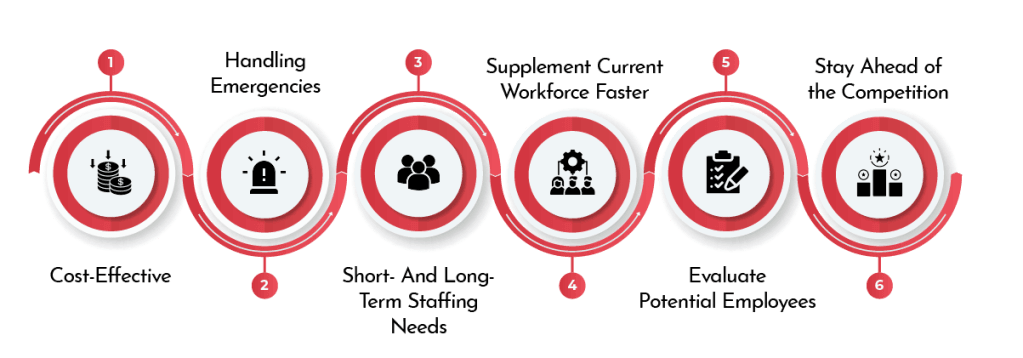In today's rapidly evolving business landscape, organizations increasingly shift from rigid workforce structures toward more adaptable approaches. Flexible staffing solutions have emerged as a strategic alternative to traditional employment models, allowing businesses to navigate market fluctuations and changing project demands. This comprehensive guide explores how Flexcrew’s flexible staffing compares to conventional/ traditional models, as well as its key benefits, implementation strategies, and potential challenges.
How is Flexcrew different?
FlexCrew addresses human resource needs differently as it enables companies to either increase or decrease the size of the workforce in response to actual business activity. Compared to staffing models like traditional employment, which have full-time employees in permanent positions, flexible staffing includes seasonal employees, independent contractors, freelance workers, part-time workers, and available skilled workers.
"Flexible staffing goes beyond the safety net- it has become a requirement for companies that want to operate and be successful in the challenging business environment, " Sarah Johnson, consultant for EmployFlex Solutions, remarked.
Businesses may alter these arrangements to meet their short-term or long-term goals. The central aim of Flexcrew’s flexible staffing is to have the right skills available from the right people at the right time with minimum long-term contractual obligations and overhead costs.
Key Characteristics of Flexible Staffing
Flexible staffing solutions normally have the following features:
Changeable number of employees: Possessing the capacity to increase or decrease employees as workload dictates
Various types of employment: Including but not limited to casual, contract, part-time, and project-based employment
Specialized hiring: Employing persons with certain skill sets for targeted activities or projects
Lowered permanent fixed costs: Reduced long-term expectations for costs of employee benefits, space, and training
Use of technology: Feeding, organizing, and managing workers electronically
Freedom concerning the location: Ability to obtain services from any part of the world and remotely working
As per the American Staffing Association, almost 16 million part-time and freelance workers in the U.S. are recruited through staffing agencies yearly, demonstrating the increased popularity of flexible staffing strategies.

Traditional Staffing Models vs. FlexCrew
Definition of Traditional Staffing Models
Regular staffing models generally include:
Employees who are full-time and permanent.
Set working hours (usually 9 a.m. to 5 p.m., Monday through Friday).
Vague and rigid job titles with little variance.
Advancement within a lower and upper meridian of the organization.
Elaborate provider benefits.
Relocation and attendance at the company premises.
These models were created within the framework of the industrial paradigm, where functions within a business were more standardized, and the scope of activities within companies was relatively stable over time.
Comparative Analysis
Traditional Staffing Benefits:
Former employees remaining associated with the institution provide them with consistency and knowledge.
Employees enjoy defined development opportunities.
Employees enjoy and identify with the organization, fostering team spirit.
Workers associated with the company become predictable.
In the best-case scenario, workers remain loyal to the company and do not leave frequently.
Traditional Staffing Disadvantages:
Traditional staff cannot adjust and respond to the changing specifications of business demands.
Irrespective of the business's occupancy, the company bears high fixed costs.
When new skills become essential, there may be a possibility of an influx of requisite skills.
There are limits to the region where employees meeting the required skills can be recruited.
The procedures for recruiting and dismissing employees are expensive and include a great deal of paperwork.
FlexCrew's flexible staffing Advantages:
Scaling can happen more rapidly with business needs.
Specific skills can be accessed for particular tasks.
Fixed labor costs are significantly lowered.
Workers can be evaluated before permanent engagement.
Accessing talent and geographic diversity becomes possible.
FlexCrew Disadvantages:
This may result in increased management complexity.
Possible conflicts with team integration and culture.
As reported in a Deloitte survey, 78% of respondents who employed flexible 'on-demand' staffing described noticing better responsiveness to market activity changes, about just 45% of those using more traditional models.
Benefits of FlexCrew's Flexible Staffing
Adaptability and Scalability
One of the most significant advantages of flexible staffing is the ability to adjust workforce capacity in response to:
Seasonal demand fluctuations: Retailers can quickly add staff during holiday seasons
Project-based needs: Construction companies can scale crews based on active projects
Market expansion or contraction: Businesses can test new markets without permanent commitments
Economic uncertainty: Organizations can remain agile during volatile economic periods
"The construction industry particularly benefits from flexible staffing due to the project-based nature of the work," notes Michael Torres, operations director at BuildRight Construction. "We can bring in specialized crews for specific phases without maintaining that payroll year-round."
Cost Efficiency
Reduced fixed overhead: Lower expenses related to benefits, insurance, and paid time off.
Elimination of underutilized labor: Only paying for work when it's needed
Decreased recruitment costs: Staffing agencies often handle sourcing and screening
Minimized training investment: Access to pre-skilled workers
Lower facility and equipment expenses: Fewer permanent workstations needed
A Society for Human Resource Management study found that organizations can save 15-30% on labor costs by implementing strategic flexible staffing solutions.
Access to a Broader Talent Pool
FlexCrew’s Flexible staffing opens doors to talent that might otherwise be unavailable:
Specialized skills: Access to niche skills for particular talents
Spatial diversity: The possibility to recruit anywhere in the world
Varied working styles: Employment of self-employed professionals and freelancers
Seasoned professionals: Engaging retired experts willing to work on a part-time basis
Business strategy: Engaging high-caliber professionals without forcing relocation
Based on McKinsey’s research, 87% of businesses claim they have or expect to have a skills shortage within the next few years – staffing with more flexibility presents a great opportunity for this increasing concern.

Implementing Flexible Staffing in Your Business
Steps to Transition from Traditional to Flexible Staffing
1. Assess Your Workforce Needs
Identify roles and tasks that non-permanent staff can handle.
Determine key operational positions that require full-time employees.
Analyze work cycles to pinpoint peak and off-peak labor demand.
2. Define Your Goals for Flexible Staffing
Establish clear objectives for integrating FlexCrew into your workforce.
Set measurable benchmarks to evaluate success.
Create a timeline for implementing flexible staffing solutions.
3. Partner with FlexCrew for the Right Talent
Leverage FlexCrew’s expertise in sourcing skilled professionals.
Review our candidate selection process to ensure quality staffing.
Assess past success stories and references to build confidence in our approach.
4. Update Onboarding and Policy Guidelines
Work with FlexCrew to streamline orientation for temporary staff.
Define feedback and performance assessment standards.
Establish communication channels between your permanent staff and FlexCrew hires.
Addressing Common Challenges
Problem: Cultural Integration
Solution: Develop an onboarding framework that captures the essence of company philosophy and mission statements
Establish buddy systems in which existing permanent staff members take on temporary employees as buddies
Ensure that other staff members at the company include non-permanent employees in relevant communications and events
Problem: Knowledge Management
Solution: Establish good processes for documentation
Create knowledge transfer sessions for departing employees and new hires
Provide knowledge repositories that all users can access
Problem: Quality Control
Solution: Set specific standard requirements to be met by each employee
Develop internal procedures to ensure a specified quality of your company
Build a network of reliable recruitment agencies that validate the resumes of candidates before submission
Problem: Legal and Compliance Issues
Solution: Contract an attorney whose specialty is employment law
Describe in detail the classifications of workers and their roles within the organization
Monitor changes in policies that are likely to impact non-permanent workers in the company
Problem: Security Issues
Solution: Design security clearance to have access based on position and length of service
Ensure that all employees who leave the company do so under proper supervision
Restrict access to information for some workers and develop appropriate security measures for them
According to a 2024 Gartner report, organizations that proactively address these challenges experience 35% higher success rates with flexible staffing initiatives.
Conclusion
FlexCrew offers an appealing tactic for modern businesses wanting to remain competitive in the fast-paced market. Through FlexCrew, construction industry businesses and others can improve agility, cost, and specialized talent access while minimizing long-term commitments.
Moving from fixed staffing paradigms to a more flexible model requires detailed strategies and effective organizational communication. Although problems do exist, they can be handled efficiently with proper implementation and best practices.
By the time we reach the end of 2025, the importance of adjusting the workforce to a business's shifting demands and requirements will be significant. Companies that use flexible staffing approaches tend to be the first to adapt to market changes, take advantage of new opportunities, and be competitive in an ever-changing business world.
FAQs
What is FlexCrew?
FlexCrew provides organizations with temporary, contract, part-time, or project-based workers based on their specific needs. These services include talent sourcing, screening, placement, and often administrative management of contingent workers. They enable businesses to adjust workforce capacity without the long-term commitments associated with permanent hiring.
How does FlexCrew’s flexible staffing solution compare with traditional models?
Traditional staffing involves permanent employees with fixed schedules and comprehensive benefits, offering stability but limited adaptability. FlexCrew solution's scalability, cost efficiency, and specialized talent access may challenge cultural integration and knowledge continuity. The best approach often combines both models, maintaining a core permanent team supplemented by flexible staff.
How can businesses implement flexible staffing solutions?
Implementation begins with assessing workforce needs and identifying suitable roles for flexible arrangements. Businesses should develop a strategic plan, select appropriate staffing partners, update relevant policies, prepare their permanent team, implement supporting technology, and continuously monitor results. Starting with a pilot program and gradually expanding can help manage the transition effectively.
What are the common challenges in flexible staffing?
Common challenges include cultural integration of temporary workers, maintaining knowledge continuity during transitions, ensuring consistent quality, managing a diverse workforce, navigating compliance issues, addressing security concerns, and managing training inefficiencies. These challenges can be mitigated through proper planning, clear communication, robust documentation, and strategic partnerships with reliable staffing providers.


